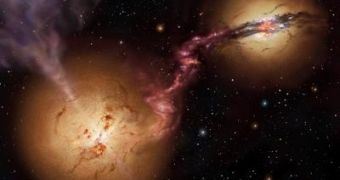New observations performed by the Hawaii-based Submillimeter Array's eight antennas indicated that massive black holes had been common since the early ages of the universe. The recent discovery of the collision of two ancient galaxies brought new data on the behavior of black holes.
As the artist's concept, showed in the adjacent picture, reveals, two very old galaxies smashed together. The one to the left of the image has already depleted its star-forming gas resources, while the black hole at its core ejects two giant beams of particles in opposite directions. The leftmost galaxy feeds on material from the galaxy to the right, the black hole of which fuels a shining pulsar, only dimmed by the surrounding enormous quantity of dust and gas left from the impact. This galaxy uses its gas in order to spawn young stars at an incommensurable rate (about 5.000 sun equivalents yearly). These galaxies are 12 billion years old, among the youngest formed after the Big Bang.
Previously, scientists believed that 4C60.07 (the one to the left) was a single galaxy, but the new observations indicated that, in fact, both of them had collided. “This new image reveals two galaxies where we only expected to find one,” explains Rob Ivison from the UK Astronomy Technology Center, the main author of the research. “Remarkably, both galaxies contain supermassive black holes at their centers, each capable of powering a billion, billion, billion light bulbs. The implications are wide-reaching: you can't help wondering how many other colossal black holes may be lurking unseen in the distant universe.” The image shows the galaxies as they looked 12 billion years ago, when the event occurred, since the light speed took this too far away to reach our planet. By now, experts believe they merged into an oblong galaxy in the shape of a football. Their giant black holes also joined into an enormous one.

 14 DAY TRIAL //
14 DAY TRIAL //